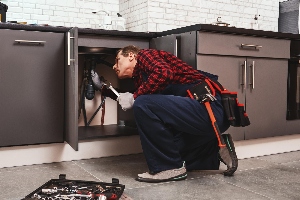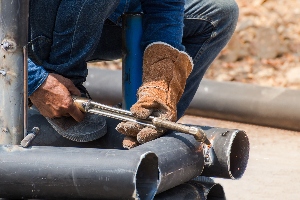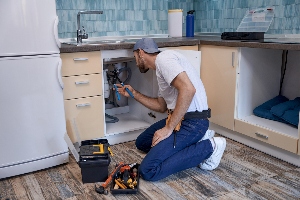A sump pump that isn't working properly can quickly lead to basement flooding and water damage in your home. When your sump pump fails, it's important to identify the problem quickly to prevent costly repairs.
The most common causes of sump pump failure include power outages, switch problems, clogged intake or discharge pipes, improper installation, and motor burnout.
Before investigating any sump pump issues, safety must come first. Always disconnect the power to your basement before entering a flooded area to avoid dangerous electrical shocks. Once it's safe to check your system, look for obvious problems like a tripped circuit breaker or a clogged discharge pipe.
We often find that sump pumps appear to be working but no water is entering the pit, which typically indicates an installation problem or issues with your drainage system.
Regular maintenance and awareness of these common problems can help extend the life of your sump pump and keep your basement dry. Working with waterproofing experts can ensure your system is properly installed and functioning correctly.
In this article, you’ll learn why your sump pump may not be working and how to troubleshoot common failures.
Here’s what you need to know to fix issues fast and avoid basement flooding:
- Common reasons your sump pump stopped working
- How to troubleshoot a sump pump that's not turning on
- When to repair vs. when to replace your sump pump
- Call One Call Plumbing for sump pump repair in South Carolina
Let's dive in!
Common reasons your sump pump stopped working
Sump pumps can fail for several reasons, often related to electrical issues, mechanical problems, or blockages in the system. Understanding these common failure points can help you identify and fix problems quickly.
Power loss or tripped circuit
Power issues are the most common reason for sump pump failure. During heavy storms, when you need your sump pump most, power outages can occur. This is why having a backup system is crucial.
Check if your pump is properly plugged in and that the circuit hasn't tripped. If you find a tripped breaker, reset it and monitor to see if it happens again. Frequent tripping may indicate electrical problems that need professional attention.
Consider installing a battery backup system. These systems automatically kick in when main power fails, providing several hours of protection during outages.
Another option is a water-powered backup pump that uses your home's water pressure to function without electricity. For complete peace of mind, a generator can power your entire system during extended outages.
Float switch failure
The float switch activates your pump when water reaches a certain level. If it's stuck or malfunctioning, your pump won't turn on when needed.
Common float issues include:
- Stuck float: The float arm may get caught on the side of the sump pit or other components
- Debris interference: Dirt and debris can prevent proper movement
- Switch failure: The switch mechanism itself can wear out over time
To check your float switch, first unplug the pump for safety. Then manually move the float to see if it moves freely. Clean any debris around the float arm. If the float moves properly but the pump still doesn't activate when plugged back in, the switch may need replacement.
Regular testing every few months will help catch float problems before they lead to flooding.
Clogged intake or discharge line
Blockages prevent water from either entering or leaving your sump pump system. This common issue reduces efficiency or completely stops pump function.
The intake screen at the bottom of your pump can become clogged with:
- Small stones
- Dirt and mud
- Debris from construction
- Toys or other foreign objects
Your discharge pipe can also become blocked, especially at the check valve or where the pipe exits your home. In winter, frozen discharge pipes are a particular problem.
To fix intake clogs, unplug the pump, remove it from the pit, and clean the screen thoroughly. For discharge pipe issues, check for visible blockages at the outlet and inspect the check valve for proper operation.
Installing a protective cover over your sump pit helps prevent debris from entering the system.
Burned-out motor or jammed impeller
Motor failure often happens when pumps run continuously or work too hard during heavy flooding. Impeller problems can occur when debris gets caught in the mechanism.
Signs of motor issues include:
- Unusual noises (grinding, rattling)
- Pump runs but moves little or no water
- Motor feels hot to touch
- Burning smell during operation
If the impeller is jammed, sometimes removing debris will solve the problem. Unplug the pump, turn it upside down, and inspect for objects caught in the impeller.
For motor burnout, replacement is usually necessary. Most sump pumps last 7-10 years with proper maintenance. If yours is approaching this age and showing problems, consider replacing the entire unit rather than just repairing components.
Regular maintenance every 3-4 months helps prevent these issues and extends the life of your pump.
How to troubleshoot a sump pump that's not turning on
When your sump pump fails to turn on, quick action can prevent basement flooding. Finding the cause often involves checking a few key components in a systematic way.
Check the power source and reset the unit
First, verify that your sump pump is receiving power. Look for unplugged cords or tripped circuit breakers at your breaker panel. Many homeowners don't realize that power issues cause most pump failures.
If the pump is plugged in but still not working, check if it's connected to a GFCI outlet that may have tripped. Press the reset button on the outlet to restore power.
Test the outlet with another device to confirm it's working properly. Sometimes the issue is as simple as a blown fuse or a loose connection.
For battery backup systems, check that the battery has sufficient charge and that terminals are clean and properly connected. Batteries typically need replacement every 2-5 years.
Test the float manually
The float switch is what activates your pump when water reaches a certain level. If it's stuck or faulty, your pump won't turn on even when needed.
Locate the float switch on your sump pump and gently lift it to see if the pump activates. If lifting the float doesn't start the pump, the switch may be defective or stuck.
Check for debris or obstructions that might prevent the float from moving freely. Sometimes the float arm gets caught on the side of the basin or on pipes.
Make sure the float isn't positioned too high in the pump basin. If it's set too high, water levels may never reach the activation point.
Inspect the discharge pipe for blockage
A clogged discharge line can create back pressure that prevents your pump from starting or functioning properly. This is especially common after winter.
Examine the entire discharge line for kinks, bends, or visible blockages. The pipe should have a continuous downward slope away from your home.
Check the exterior outlet of the discharge line for ice, debris, or mud. Even small blockages can cause significant problems with pump function.
If you suspect a blockage inside the pipe, you might need to disconnect and flush the line with water from your garden hose. Always turn off power to the pump before performing this task.
Look for water in the pit: is the pump overwhelmed or dry?
Sometimes the issue isn't with the pump but with water conditions in the basin. Both too much and too little water can cause problems.
Check the water level in your sump pit. If it's completely dry, your pump has nothing to pump and won't activate. This is normal during dry seasons.
If the pit is overflowing, your pump might be overwhelmed by an unusually heavy influx of water. In this case, you might need a higher capacity pump or a secondary backup system.
Look for signs that the impeller might be clogged with debris, preventing the pump from moving water. This often happens with older systems or after construction work.
Make sure the pump is properly positioned at the bottom of the basin and isn't tilted or fallen over, which can prevent proper operation.
When to repair vs. when to replace your sump pump
Making the right decision between repairing or replacing your sump pump can save you money and prevent water damage to your home. The choice depends on several factors including the age of your unit, how often it runs, and the severity of the problems you're experiencing.
According to FEMA and the Insurance Information Institute, water damage claims—often caused by sump pump failures—average nearly $14,000 per incident. Choosing timely replacement over repeat repairs can prevent one of the costliest issues faced by homeowners.
Age and type of pump (submersible vs pedestal)
The type of sump pump you have significantly impacts its expected lifespan. Submersible sump pumps typically last 5-7 years with proper maintenance. These units sit inside the sump pit and are fully submerged in water.
Pedestal sump pumps generally last longer, often 10-15 years, because their motors remain above water level, reducing exposure to moisture and debris. This design makes them easier to access for repairs but slightly noisier than submersible models.
We recommend considering replacement rather than repair when:
- Your submersible pump exceeds 7 years of age
- Your pedestal pump is over 15 years old
- The cost of repairs approaches 50% of replacement cost
Age-related wear affects efficiency even after repairs, making newer models a better investment for older units.
Frequency of use and past repairs
How often your sump pump runs directly affects its longevity. Pumps in areas with high water tables work harder and wear out faster than those in drier regions.
If your pump runs frequently during rainy seasons or year-round, it may need replacement sooner. Keep track of repair history - multiple fixes within a short period often signal declining reliability.
Consider these repair-vs-replace guidelines:
- Repair if: This is the first malfunction within 2-3 years
- Replace if: You've needed repairs 2+ times in the past year
- Replace if: The motor struggles noticeably during operation
Repeat repairs for the same issue typically indicate the pump is approaching the end of its useful life. We find that investing in a new unit often provides greater peace of mind than continual repairs.
Signs it's time for a more powerful or updated unit
Sometimes the issue isn't about repair but about having the right pump for your needs. Your current pump may be underpowered if it runs continuously without clearing water effectively.
Warning signs you need an upgrade:
- Pump runs constantly during moderate rainfall
- Water accumulation despite a functioning pump
- Circuit breaker trips frequently when pump operates
- Unusual noises (grinding, rattling, clicking)
- Visible corrosion or rust on components
Modern sump pumps offer improved efficiency and features like battery backups, water-level alarms, and self-testing capabilities. We've found these advances particularly valuable in areas prone to power outages or flooding.
Upgrading provides an opportunity to address underlying issues rather than just fixing symptoms of an inadequate system.
Call One Call Plumbing for sump pump repair in South Carolina
One Call Plumbing provides expert sump pump repair services in Greenville and Spartanburg, SC. We specialize in diagnosing pump failures, offering emergency response, and providing comprehensive solutions to protect your home from water damage.
Fast diagnosis and emergency response
When your sump pump fails, water damage can happen quickly. Our licensed plumbers respond to emergency calls promptly, often arriving within hours to assess the situation. We bring specialized testing equipment to identify common issues like switch malfunctions, power problems, or clogged discharge pipes.
Our technicians follow a systematic troubleshooting process to pinpoint exactly what's wrong with your pump. This careful diagnosis prevents unnecessary repairs and saves you money.
For emergency situations, we prioritize getting your pump operational quickly. We stock common replacement parts in our service vehicles to complete many repairs in a single visit.
Pump upgrades and installation available
If your sump pump needs replacement, we offer various models to suit different needs and budgets. Our selection includes:
- Primary pumps with different horsepower ratings
- Battery backup systems that work during power outages
- Combination systems with both primary and backup pumps
- Smart pumps with remote monitoring capabilities
We can upgrade your existing setup with more efficient models that use less electricity while providing better protection. During installation, we ensure proper sizing for your basin and correct discharge pipe configuration.
All new pumps come with manufacturer warranties, and we provide a workmanship guarantee on our installations.
Basement waterproofing and long-term drainage solutions
Beyond just fixing your pump, we address the bigger picture of basement water management. Our comprehensive approach includes:
- Evaluating your entire drainage system
- Checking for foundation cracks or entry points
- Recommending perimeter drain systems when needed
- Installing moisture barriers to prevent humidity damage
We can add water alarms to alert you of rising water levels before damage occurs. For homes with serious water issues, we design custom solutions that may include multiple pumps or drainage improvements.
Our waterproofing services help prevent the conditions that cause sump pumps to fail in the first place. This proactive approach saves you money on emergency repairs and protects your home's value.
Conclusion
A working sump pump is essential for keeping your basement dry and preventing water damage. We've covered several common issues that might cause your pump to fail, from power problems to clogs and mechanical failures.
Regular maintenance is the key to avoiding most sump pump problems. We recommend cleaning your pump and checking for debris every 3-4 months. Don't forget to test the float switch regularly to ensure it moves freely.
Safety should always come first! Never work on your sump pump without disconnecting the power. Water and electricity create dangerous conditions that can lead to serious injury.
Remember that small problems can become big emergencies during heavy rain. Taking a few minutes to maintain your sump pump now can save thousands of dollars in potential water damage later.
FEMA data shows that nearly 98% of basements in the U.S. will experience water damage during their lifespan—reinforcing why sump pump upkeep is not optional but essential.
If you've tried our troubleshooting tips and your pump still isn't working properly, it may be time to call a professional plumber.
For fast sump pump repair or replacement in Greenville and Spartanburg, call One Call Plumbing and protect your home from costly water damage.












